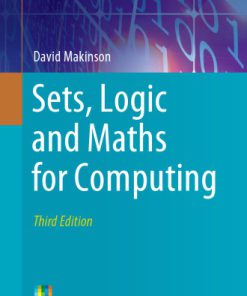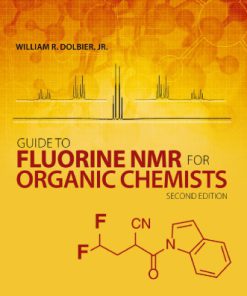Maths for Chemists 2nd Edition by Martin Cockett, Graham Doggett ISBN 9781782624950 1782624953
$50.00 Original price was: $50.00.$25.00Current price is: $25.00.
Maths for Chemists 2nd Edition by Martin Cockett, Graham Doggett – Ebook PDF Instant Download/Delivery: 9781782624950 ,1782624953
Full download Maths for Chemists 2nd Edition after payment
Product details:
ISBN 10: 1782624953
ISBN 13: 9781782624950
Author: Martin Cockett, Graham Doggett
Maths for Chemists 2nd Edition Table of contents:
1 Numbers and Algebra
1.1 Real Numbers
1.1.1 Integers
1.1.2 Rational Numbers
1.1.3 Irrational Numbers
1.1.4 Decimal Numbers
1.1.4.1 Working with Decimal Numbers
1.1.4.2 Observations on Rounding
1.1.4.3 Rounding Errors
1.1.5 Combining Numbers
1.1.5.1 Powers or Indices
1.1.5.2 Rational Powers
1.1.5.3 Further Properties of Indices
1.1.6 Scientific Notation
1.1.6.1 Combining Numbers Given in Scientific Form
1.1.6.2 Names and Abbreviations for Powers of Ten
1.1.7 Relationships Between Numbers
1.1.7.1 Negative Numbers
1.1.7.2 Very Large and Very Small Numbers
1.1.7.3 Infinity
1.1.7.4 The Magnitude
1.2 Algebra
1.2.1 Generating a Formula for the Sum of the First n Positive Integers
1.2.2 Algebraic Manipulation
1.2.2.1 Dealing with Negative and Positive Signs
1.2.2.2 Working with Rational Expressions
1.2.3 Polynomials
1.2.3.1 Factorising a Polynomial
1.2.3.2 Forming a Common Denominator
1.2.4 Coping with Units
Summary of Key Points
2 Functions and Equations: Their Form and Use
2.1 Defining Functions
2.1.1 Functions in a Chemical Context
2.1.1.1 Understanding the Role of Units – The Mathematically Correct Approach
2.1.1.2 Creating a Function from a Formula
2.1.1.3 Understanding the Role of Units – The Pragmatic Approach
2.2 Representation of Functions
2.2.1 Tabular Representations of Functions of a Single Variable
2.2.2 Graphical Representations of Functions of a Single Variable
2.2.2.1 A Chemical Example of a Point Plot
2.2.2.2 Improving on the Boyle Model
2.2.3 Representing a Function in Terms of a Prescription
2.2.3.1 Prescription Functions in Chemistry
2.3 Some Special Mathematical Functions
2.3.1 Exponential Functions
2.3.1.1 Two Chemical Examples
2.3.2 Logarithm Functions
2.3.2.1 Defining the Logarithm Function
2.3.2.2 Properties of Logarithms
2.3.3 Trigonometric Functions
2.3.3.1 The Question of Angle
2.3.3.2 Angle Measure in S.I. Units
2.3.3.3 Sign Conventions for Angles and Trigonometric Functions
2.3.3.4 Special Values for Trigonometric Functions
2.3.3.5 Reciprocal Trigonometric Functions
2.3.3.6 Domains and Periodic Nature of Trigonometric Functions
2.3.3.7 Important Identities Involving Trigonometric Functions
2.3.3.8 Further Important Properties of Trigonometric Functions
2.3.4 Exponential Functions with Base e Revisited
2.3.4.1 Symmetric and Antisymmetric Functions
2.3.4.2 The Product Function x2e x
2.3.4.3 Product of a Polynomial or Trigonometric Function with an Exponential Function
2.3.4.4 A Chemical Example: The 3s Atomic Radial Wave Function for the Hydrogen Atom
2.3.5 Explicit and Implicit Functions
2.4 Equations
2.4.1 An Algebraic Method for Finding Roots of Polynomial Equations
2.4.2 Solving Polynomial Equations in a Chemical Context
2.4.2.1 Polynomial Equations of Higher Degree in Chemistry
2.4.2.2 Examples of Cubic Polynomial Equations in Physical Chemistry
Summary of Key Points
3 Limits
3.1 Mathematical and Chemical Examples
3.1.1 Point Discontinuities
3.1.2 Limiting Behaviour for Increasingly Large Positive or Negative Values of the Independent Variable
3.1.3 Limiting Behaviour for Increasingly Small Values of the Independent Variable
3.2 Defining the Limiting Process
3.2.1 Finding the Limit Intuitively
3.2.2 An Algebraic Method for Evaluating Limits
3.2.3 Evaluating Limits for Functions Whose Values Become Indeterminate
3.2.4 The Limiting Form of Functions of More Than One Variable
Summary of Key Points
4 Differentiation
4.1 The Average Rate of Change
4.2 The Instantaneous Rate of Change
4.2.1 Differentiation from First Principles
4.2.2 Differentiation by Rule
4.2.2.1 Some Standard Derivatives
4.2.2.2 An Introduction to the Concept of the Operator
4.2.3 Basic Rules for Differentiation
4.2.4 Chain Rule
4.3 Higher Order Derivatives
4.3.1 Operators Revisited: An Introduction to the Eigenvalue Problem
4.3.1.1 The Eigenvalue Problem
4.4 Maxima, Minima and Points of Inflection
4.4.1 Finding and Defining Stationary Points
4.4.1.1 Turning Points (Maxima and Minima)
4.4.1.2 Points of Inflection
4.5 The Differentiation of Functions of Two or More Variables
Summary of Key Points
5 Differentials
5.1 The Effects of Incremental Change
5.1.1 The Concept of Infinitesimal Change
5.1.1.1 The Origins of the Infinitesimal
5.1.2 Differentials in Action
5.2 The Differential of a Function of Two or More Variables
5.3 The Propagation of Errors
Summary of Key Points
6 Integration
6.1 Reversing the Effects of Differentiation
6.2 The Definite Integral
6.2.1 Finding the Area Under A Curve The Origin of Integral Calculus
6.2.1.1 Negative ‘Areas’
6.2.2 A Chemical Example: Where is the Electron in the Hydrogen Atom?
6.3 The Indefinite Integral
6.4 General Strategies for Solving More Complicated Integrals
6.4.1 Integration by Parts
6.4.2 Integration Using the Substitution Method
6.4.2.1 Use of Trigonometrical Substitutions
6.4.2.2 General Comment
6.5 The Connection Between the Definite and Indefinite Integral
Summary of Key Points
7 Differential Equations
7.1 Using the Derivative of a Function to Create a Differential Equation
7.2 Some Examples of Differential Equations Arising in Classical and Chemical Contexts
7.3 First Order Differential Equations
7.3.1 F(x, y) is Independent of y
7.3.2 Boundary Conditions
7.3.3 F(x, y) is in the Form F(x)G(y)
7.3.3.1 Separation of Variables Method
7.3.4 Separable First Order Differential Equations in Chemical Kinetics
7.3.5 First Order Differential Equations Linear in y
7.3.5.1 The Constant of Integration
7.3.6 First Order Differential Equations in Radioactive Decay Processes
7.3.7 First Order Differential Equations in Chemical Kinetics Processes
7.4 Second Order Differential Equations
7.4.1 Simple Harmonic Motion
7.4.2 Second Order Differential Equations with Constant Coefficients
7.4.3 How is an Eigenvalue Problem Recognised?
7.4.3.1 The Search for Eigenfunctions
Summary of Key Points
8 Power Series
8.1 Sequences
8.1.1 Finite Sequences
8.1.1.1 The Geometric Progression
8.1.1.2 Arithmetic Progression
8.1.2 Sequences of Indefinite Length
8.1.3 Functions Revisited
8.2 Finite Series
8.3 Infinite Series
8.3.1 π Revisited – The Rate of Convergence of an Infinite Series
8.3.2 Testing a Series for Convergence
8.3.2.1 The Ratio Test
8.3.2.2 The Infinite Geometric Series
8.4 Power Series as Representations of Functions
8.4.1 The Maclaurin Series: Expansion about the Point x = 0
8.4.1.1 The Maclaurin Series Expansion for ex
8.4.1.2 Truncating the Exponential Power Series
8.4.1.3 The Maclaurin Expansions of Trigononometric Functions
8.4.1.4 The Problem with Guessing the General Term: A Chemical Counter Example
8.4.2 The Taylor Series: Expansion about Points other than Zero
8.4.3 Manipulating Power Series
8.4.3.1 Combining Power Series
8.4.3.2 A Shortcut for Generating Maclaurin Series
8.4.4 The Relationship Between Domain and Interval of Convergence
8.4.5 Limits Revisited: Limiting Forms of Exponential and Trigonometric Functions
8.4.5.1 Exponential Functions
8.4.5.2 Trigonometric Functions
Summary of Key Points
9 Numbers Revisited: Complex Numbers
9.1 The Imaginary Number i
9.2 The General Form of Complex Numbers
9.3 Manipulation of Complex Numbers
9.3.1 Addition, Subtraction and Multiplication
9.3.2 The Complex Conjugate
9.3.3 Division of Complex Numbers
9.4 The Argand Diagram
9.4.1 The Modulus and Argument of z
9.5 The Polar Form for Complex Numbers
9.5.1 Euler’s Formula
9.5.1.1 The Number eiπ
9.5.2 Powers of Complex Numbers
9.5.3 The De Moivre Theorem
9.5.4 Complex Functions
9.5.4.1 The Periodicity of the Exponential Function
9.5.4.2 The Eigenvalue Problem Revisited
9.5.4.3 Structure Factors in Crystallography
9.5.5 Roots of Complex Numbers
Summary of Key Points
10 Working with Arrays I: Determinants
10.1 Origins – The Solution of Simultaneous Linear Equations
10.2 Expanding Determinants
10.3 Properties of Determinants
10.4 Strategies for Expanding Determinants Where n > 3
Summary of Key Points
11 Working with Arrays II: Matrices and Matrix Algebra
11.1 Introduction: Some Definitions
11.2 Rules for Combining Matrices
11.2.1 Multiplication of a Matrix by a Constant
11.2.2 Addition and Subtraction of Matrices
11.2.3 Matrix Multiplication
11.2.3.1 Properties of Matrix Multiplication
11.3 Origins of Matrices
11.3.1 Coordinate Transformations
11.3.1.1 Sequential Linear Transformations
11.3.2 Coordinate Transformations in Three Dimensions: A Chemical Example
11.4 Operations On Matrices
11.4.1 The Transpose of a Matrix
11.4.2 The Complex Conjugate Matrix
11.4.3 The Complex Conjugate Transposed Matrix
11.4.4 The Trace of a Square Matrix
11.4.5 The Matrix of Cofactors
11.5 The Determinant of a Product of Square Matrices
11.6 Special Matrices
11.6.1 The Null Matrix
11.6.2 The Unit Matrix
11.7 Matrices with Special Properties
11.7.1 Symmetric Matrices
11.7.2 Orthogonal Matrices
11.7.3 Singular Matrices
11.7.4 Hermitian Matrices
11.7.5 Unitary Matrices
11.7.6 The Inverse Matrix
11.8 Solving Sets of Linear Equations
11.8.1 Solution of Linear Equations: A Chemical Example
11.9 Molecular Symmetry and Group Theory
11.9.1 An Introduction to Group Theory
11.9.2 Groups of Matrices
11.9.3 Group Theory in Chemistry
Summary of Key Points
12 Vectors
12.1 The Geometric Construction of Vectors
12.1.1 Vectors in Two Dimensions
12.1.2 Conventions
12.2 Addition and Subtraction of Vectors
12.2.1 Vector Addition
12.2.2 Vector Subtraction
12.3 Base Vectors
12.3.1 The Magnitude of a Vector in Three Dimensional Space
12.3.2 Vector Addition, Subtraction and Scalar Multiplication Using Algebra
12.4 Multiplication of Vectors
12.4.1 Scalar Product of Two Vectors
12.4.1.1 Specifying the Angle θ
12.4.1.2 The Scalar Product in the Chemical Context
12.4.1.3 Scalar Products of Vectors Expressed in Terms of Base Vectors
12.4.1.4 Finding the Angle Between Two Vectors
12.4.1.5 Simple Application of the Scalar Product: the Cosine Law for a Triangle
12.4.2 Vector Product of Two Vectors
12.4.2.1 Vector Products in a Chemical Context
12.4.3 Area of a Parallelogram
12.5 Matrices and Determinants Revisited: Alternative Routes to Evaluating Scalar and Vector Products
12.5.1 The Scalar Product
12.5.2 The Vector Product
12.5.3 The Scalar Triple Product
Summary of Key Points
13 Simple Statistics and Error Analysis
13.1 Errors
13.1.1 Systematic Errors
13.1.2 Random Errors
13.2 The Statistics of Repeated Measurement
13.2.1 The Binomial Distribution
13.2.2 The Gaussian Distribution
13.2.2.1 The Mean, Variance and Standard Deviation
13.2.2.2 The Sample Variance and Sample Standard Deviation
13.2.2.3 Confidence Intervals
13.2.2.4 Standard Error of the Mean and Standard Error of the Sample Mean
13.2.2.5 Student t-Factors and the 95% Confidence Limit
13.3 Linear Regression Analysis
13.3.1 The Least Squares Method
13.3.1.1 Finding the Best Gradient and y Intercept
13.3.1.2 Finding the Uncertainties Associated with the Gradient and y Intercept
13.4 Propagation of Errors
13.4.1 Uncertainty in a Single Variable
13.4.2 Combining Uncertainties in More Than One Variable
Summary of Key Points
Worked Answers to Problems
Glossary
Subject Index
People also search for Maths for Chemists 2nd Edition:
mathematics for chemistry pdf
maths for chemists book pdf
mathematics for chemists book pdf
maths for chemists pdf
Tags:
Martin Cockett,Graham Doggett,Maths,Chemists
You may also like…
Mathematics
Jurisprudence & Law - Environmental Law
Environmental Criminology 2nd Edition by Martin A Andresen ISBN 1138317012 978-1138317017
Uncategorized
Chemistry - Organic Chemistry
Guide to Fluorine NMR for Organic Chemists 2 ed 2nd Edition Dolbier William R.













